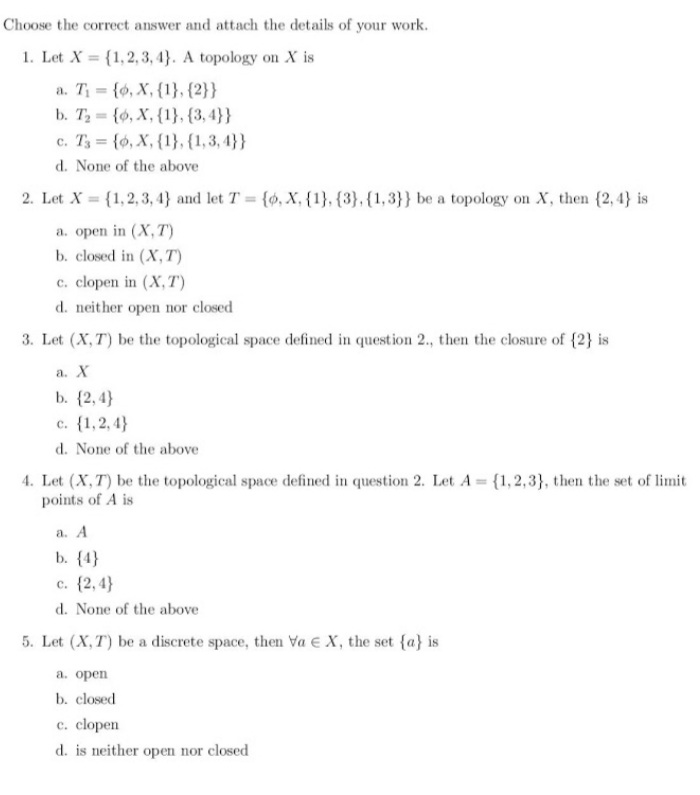1. Let X {1,2, 3, 4}. A topology on X is a. T = {6, X, {1}, {2}} b. T = {6, X, {1}, (3, 4}} c. T3 = {6, X, {1}, {1,3, 4}} d. None of the above
1. Let X {1,2, 3, 4}. A topology on X is a. T = {6, X, {1}, {2}} b. T = {6, X, {1}, (3, 4}} c. T3 = {6, X, {1}, {1,3, 4}} d. None of the above
Elementary Geometry For College Students, 7e
7th Edition
ISBN:9781337614085
Author:Alexander, Daniel C.; Koeberlein, Geralyn M.
Publisher:Alexander, Daniel C.; Koeberlein, Geralyn M.
Chapter4: Quadrilaterals
Section4.1: Properties Of A Parallelogram
Problem 44E
Related questions
Question

Transcribed Image Text:Choose the correct answer and attach the details of your work.
1. Let X = {1,2,3, 4}. A topology on X is
a. T = {0, X, {1}, {2}}
b. T2 = {6, X, {1}, {3, 4}}
c. T3 {6, X, {1}, {1,3, 4}}
d. None of the above
2. Let X = {1,2, 3, 4} and let T = {6, X, {1}, {3}, {1,3}} be a topology on X, then (2, 4} is
%3D
a. open in (X, T)
b. closed in (X, T)
c. clopen in (X,T)
d. neither open nor closed
3. Let (X,T) be the topological space defined in question 2., then the closure of (2} is
а. X
b. {2, 4}
c. {1,2, 4}
d. None of the above
4. Let (X,T) be the topological space defined in question 2. Let A = {1,2,3}, then the set of limit
points of A is
a. A
b. {4}
c. {2, 4}
d. None of the above
5. Let (X,T) be a discrete space, then Va e X, the set {a} is
а. орen
b. closed
c. clopen
d. is neither open nor closed
![6. Let (X,T) be a topological space such that every subset of X is closed, then
a. (X,T) is an indiscrete space.
b. (X,T) is a discrete space
c. T is the finite closed topology on X
d. None of the above
7. Let X be an infinite set equipped with the finite closed topology. A finite subset of X is
a. closed
b. орen
c. clopen
d. neither open nor closed
8. We define the real valued function f(r) = r. The inverse image of {-9,-1,0, 4} is
a. {0,1,2, 3}
b. {0,2}
c. {-2,0, 2}
d. None of the above
x- 2, r<0,
|r+2, r20'
9. Let f : R +R be defined by f(x) =
, then f-(]1,3[) (the inverse image of the
interval ]1, 3[ under f) is
(a) ]3,5[U] – 1,1[
(b) [0, 1[
(c) 1-1,1[
(d) None of the above
10. Let (X, Tx) and (Y, Ty) be two topological spaces, such that
X = {a, b,c, d}, Tx = {0, X, {a}, {a, b}, {a, b, c}}
Y = {1,2,3, 4}, Ty = {ó,Y, {2}, {2,3, 4}}
Consider the functions f : X →Y and g: X Y defined by
f(a) = f(b) = 2, f(c) = 4, f(d) = 3
g(a) = g(b) = 9(d) = 2, g(c) = 3
Then
(a) f and g are both continuous
(b) f and g are both discontinuous
(c) f is discontinuous and g is continuous
(d) f is continuous and g is discontinuous](/v2/_next/image?url=https%3A%2F%2Fcontent.bartleby.com%2Fqna-images%2Fquestion%2F54ef91fd-7536-4a13-aa77-2eac2c49f6d4%2F640a4be5-de61-405a-a698-cd53f53d68c6%2F4ctehxg_processed.jpeg&w=3840&q=75)
Transcribed Image Text:6. Let (X,T) be a topological space such that every subset of X is closed, then
a. (X,T) is an indiscrete space.
b. (X,T) is a discrete space
c. T is the finite closed topology on X
d. None of the above
7. Let X be an infinite set equipped with the finite closed topology. A finite subset of X is
a. closed
b. орen
c. clopen
d. neither open nor closed
8. We define the real valued function f(r) = r. The inverse image of {-9,-1,0, 4} is
a. {0,1,2, 3}
b. {0,2}
c. {-2,0, 2}
d. None of the above
x- 2, r<0,
|r+2, r20'
9. Let f : R +R be defined by f(x) =
, then f-(]1,3[) (the inverse image of the
interval ]1, 3[ under f) is
(a) ]3,5[U] – 1,1[
(b) [0, 1[
(c) 1-1,1[
(d) None of the above
10. Let (X, Tx) and (Y, Ty) be two topological spaces, such that
X = {a, b,c, d}, Tx = {0, X, {a}, {a, b}, {a, b, c}}
Y = {1,2,3, 4}, Ty = {ó,Y, {2}, {2,3, 4}}
Consider the functions f : X →Y and g: X Y defined by
f(a) = f(b) = 2, f(c) = 4, f(d) = 3
g(a) = g(b) = 9(d) = 2, g(c) = 3
Then
(a) f and g are both continuous
(b) f and g are both discontinuous
(c) f is discontinuous and g is continuous
(d) f is continuous and g is discontinuous
Expert Solution
This question has been solved!
Explore an expertly crafted, step-by-step solution for a thorough understanding of key concepts.
Step by step
Solved in 2 steps

Knowledge Booster
Learn more about
Need a deep-dive on the concept behind this application? Look no further. Learn more about this topic, advanced-math and related others by exploring similar questions and additional content below.Recommended textbooks for you

Elementary Geometry For College Students, 7e
Geometry
ISBN:
9781337614085
Author:
Alexander, Daniel C.; Koeberlein, Geralyn M.
Publisher:
Cengage,

Elements Of Modern Algebra
Algebra
ISBN:
9781285463230
Author:
Gilbert, Linda, Jimmie
Publisher:
Cengage Learning,

Elementary Geometry For College Students, 7e
Geometry
ISBN:
9781337614085
Author:
Alexander, Daniel C.; Koeberlein, Geralyn M.
Publisher:
Cengage,

Elements Of Modern Algebra
Algebra
ISBN:
9781285463230
Author:
Gilbert, Linda, Jimmie
Publisher:
Cengage Learning,